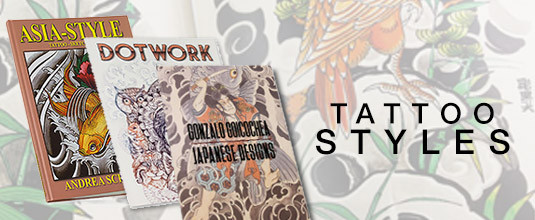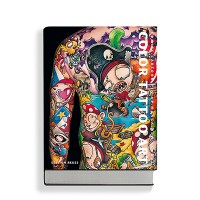Tattoo styles: Extreme! Extremes! And everything in between ...
Tattooing is an art. And just like all other arts, there are very different styles. We at Tattoosafe have put them together in a small revue. As a professional, you may already know inside out - but maybe you'll discover new possibilities here that can really fire up your creativity?
Partly, different tattoo styles - such as watercolor tattoos on the one hand and dotworks on the other - are caused by very striking differences in technique, partly by origin and tradition, such as the Asian style or Maori, partly the styles also differ in their closeness to reality; from geometric style or comic to old school, neotraditional to sophisticated realistic tattoos.
But by no means every tattoo is clearly committed to a certain style; and it doesn't have to be. On a single body, very different styles can merge into a complete work of art, and even with a single tattoo, a lively mix of styles can make up the very special charm.
Have you already found your personal tattoo style? Or are you still looking for that decisive kick? In the Tattoo Media category you will find numerous books and DVDs that can inspire you.
Learn from the sketchbooks and tutorials of the masters or explore the historical roots of your art in all its depth!
Click here to the category Tattoo Media!

Shop the Book Black & Grey Vol. 1 - Paintings and Sketches now!
Blackwork und Black & Grey: Styles for Experts and Purists
Blackwork or Black & Grey are styles that you can cultivate especially well under the sign of the tattoo REACH regulation ... And they are highly fascinating styles that carry an enormous range of design possibilities.
Both variants derive from the "biros tattoos" that prison inmates used to decorate each other with - for lack of any other color. Jack Rudy and Charlie Cartwright then refined the black-and-grey style and made it so popular that tattoos in black or with gradations towards grey have long been considered classics of the scene.
The shades of grey in the Black & Grey technique are usually achieved by diluting pure black in various proportions with distilled water. By the way, you can get these shades already perfectly premixed in the Greystar and Greywash range from Premier Products.
Click here for Premier Products tattoo colors!
Some tattoo artists also mix white and black ink to achieve this result. Black & Grey is especially popular for portraits.

Book Black & Grey Tattoo 1 - Traditional/Chicano
As the name suggests, blackwork tattoos, in contrast to black & grey tattoos, are really exclusively black and have no or hardly any shading.
Within this framework, the most diverse designs are created: from delicate ornaments in dotwork to clear-lined geometric tattoos to large black areas that adorn the body in a beautiful frame and are reminiscent of tribal tattoos.
Trash-Polka or Buena Vista tattoos: Would you like a bit more red?
The Trash Polka or Buena Vista style was invented in 1998 by the musically experienced tattoo duo Simone Pfaff and Volker Merschky in the Buena Vista Tattoo Club in Würzburg and has since become internationally popular. The highlight here is that the black and grey color palette is complemented by a powerful red, which creates a great visual tension. Otherwise, the still quite young style is open to both realistic and graphic, minimalist elements. Photo-like portraits are often combined with fonts, dots, geometric shapes or patches of color.
With a lot of flair: fineline and single-line tattoos
We know fineline tattoos as tattoos that consist of very delicate lines. The motifs are usually rather small and rich in detail; a floral ornament on the forearm, for example, or a delicate butterfly on the shoulder. For such tattoos you need a lot of experience and a very steady hand: because if a fineline tattoo is not engraved well, it tends to run or soon fade.
The hand needs to be even steadier for single-line tattoos. These are a subspecies of the fineline style, where minimalist motifs are stitched in a single line.

Book Dotwork
Dotwork: Dot by dot …
Dotwork is a very delicate technique. Here the entire motif, or at least the shading, consists entirely of individual small dots instead of the lines normally drawn when tattooing. An overall picture only emerges from a distance. Dotwork is often blackwork, i.e. stung purely with black ink. But there are also fascinating creations that bring bright colors into play dot by dot. Dotwork is especially popular for mandala motifs - in whole or in part.
Shop the Book Kalinga Tattoo now
Originally significant: Maori, Polynesisch, Samoaner, Tribal tattoos
Tā moko is the name of the traditional body decoration of the Maori, the indigenous people of New Zealand. For them and for other ancient island peoples such as the Polynesians or Samoans, the characteristic curved lines of these tattoos symbolized membership of a particular people, a tribe (hence tribal tattoos), but also the rank of their wearer in society - and sometimes they told an entire life story.
Seafarers made the fascinating indigenous motifs known in Europe. Here, tribal tattoos then broke away from their cultural tradition. Today, they are a very popular tattoo style mainly because their curved lines, adapted to the musculature, perfectly define the body, for example, they can make the biceps appear larger. In addition, the aesthetics of tribal tattoos express power and strength.
Background: Asian - Japanese, Far Eastern or Oriental Style
Especially on the Asian style, its masterpieces and its tradition, you will find a wealth of highly interesting books in our Tattoosafe "Mediathek" - just click here!
Dragons, tigers, snakes, koi, geishas, samurai warriors, cherry blossoms, demons and many other characteristically colorful and contrasting Far Eastern tattoo motifs have a very specific spiritual meaning in Asia, which can differ greatly from what we associate with the image in the Western world. So it is good if you know exactly about this background and can inform your customers about it!

Book Japanese Designs von Gonzalo Goicochea
Well-travelled: Traditional Tattoos or Old School, Sailor or American Tattoos
The tattoo style known as "Traditional", "Old School", "American" or "Sailor Tattoos" has Western roots. The hallmarks of this style are bright colors, thick outlines and a simple, two-dimensional design. The US-American tattoo artist "Sailor Jerry" (real name Norman Keith Collins, 1911-1973) contributed significantly to the spread of this style, which is indeed closely related to seafaring.
Sailors are naturally on the move a lot - and sailors have always liked to have tattoos. On their skin they collected impressions from all over the world - not only from New Zealand or Asia, but also from North America. The typical repertoire of motifs includes travel destinations, imposing animals like eagles, panthers or wolves, pretty girls like hula dancers or mermaids. But traditional European symbols such as inflamed, pierced or broken hearts, roses, skulls or swords were also popular to take out to sea. And of course, people also liked to decorate themselves with motifs of the maritime reality of life and thus their own "tribal affiliation" - i.e. with sailors, ships, anchors, nautical signs, flags or swallows.

Shop the Book Neo Traditional now
Neo-Traditional Tattoos: Can it be a bit more refined?
Neo-Traditional tattoos are a further development of the Traditional style. The clean lines and rich colors remain, but the color palette is much broader and the motifs are much more detailed, with flowing gradients and shading. Often, influences of Art Nouveau or Art Deco can be seen in Neotraditional Style, especially in the portraits of women, flowers or animals, which are particularly popular here.
Shop the Book Color Tattoo Art now
New School: Anything is possible!
Around the 1970s, a tattoo style developed that does not feel obliged to any tradition and does not attach much importance to a deeper symbolic meaning of its motifs. New School tattoos simply want to be fun - through lots of bright colors, strong contrasts and daring contour lines. They often look as if they have sprung from a comic or cartoon.
Cartoon tricks: Comic Style, Ignorant Tattoos and Kawaii
Comic tattoos in the narrower sense actually depict comic book heroes - and depending on whether they are Asterix, Mickey Mouse or Batman, they can be very colorful and cheerful, or gloomy and oppressive.
The one-dimensional, very simple and naïve, almost childlike Ignorant tattoos are also inspired by comics. With dry humour and deliberately trivial content, they stand for a conscious rejection of other tattoo styles that are overloaded with symbolism and meaning.
The modern manga world is also a rich source of comic tattoos - right up to the wondrous kawaii, which are designed to be sweet and cute by every conceivable means: with big heads and giant eyes, the kiddie scheme is cultivated here into the oversized, everything is round and "cuddly", kept in delicate, innocent pastel colors and garnished with glittery stars.
Shop the TattooSoul DVD: Mick Squires - Realistic Animal Tattooing now
The Realistic Style: Plant, animal, human and machine - a perfect illusion
Far, far away from the comic world is the realistic, photo-like tattoo style.
Whether in black and grey or in color, realistic tattoos are all about creating a 3D effect that is as close to reality as possible through structures and very fine shading. This is a great challenge that demands a lot of precision and patience from tattoo artists!
Photos are often used as templates for realistic tattoos. This style is particularly suitable for portraits of loved ones or animals. But fantasy creatures such as angels or demons also look extremely lifelike this way.
With the biomechanical style, which lets metal meet muscles and tattoos men or women as cyborgs or androids, realistic representation is also the be-all and end-all. Biomechanical tattoos were inspired by Hollywood films like the Terminator or Ridley Scott's Alien.
Watercolor: Beautifully painted on the skin
Watercolor tattoos are inspired more by painting than by reality or fantasy films. Hardly any outlines, but lots of bright, soft colors characterize this style, whose masterpieces look like watercolors painted on the skin.
The watercolor style can be combined very well with elements from other tattoo styles - there really are no limits to the creative imagination!
Which style is particularly popular with your clients? Have we forgotten an important style that you have just created? Write a comment on this post and share your knowledge with our Tattoosafe community









